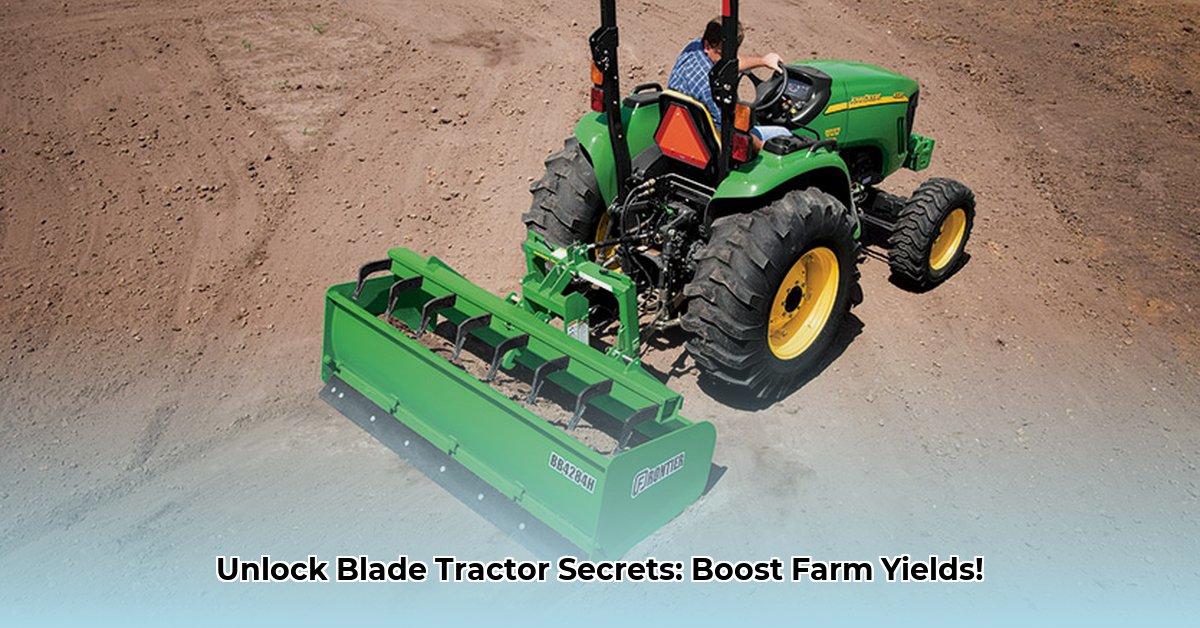
Blade Tractor: Your Guide to Efficiency and Soil Health
Choosing the right blade tractor significantly impacts your farm's efficiency and sustainability. This guide helps you select and use a blade tractor to minimize soil compaction and boost yields. We’ll cover selecting the right size and type of blade, safe operating techniques, and essential maintenance. For more detailed specifications, check out this helpful resource.
Selecting the Right Blade Tractor: Size and Task Matching
Consider your farm's size and the primary tasks. A smaller, lighter tractor suits smaller acreage, while larger operations need more powerful machines. Ditching, land leveling, or snow removal all require different blade tractor capabilities. For example, delicate landscaping benefits from a smaller, maneuverable tractor to avoid excessive soil disturbance, while extensive land leveling might necessitate a larger, more powerful model. The goal is to balance capability and practicality for maximum productivity and minimal operating costs.
Will using a bigger tractor increase efficiency? A larger blade moves more material quickly, benefiting large-scale land preparation. However, this might be overkill for smaller jobs or delicate work, potentially increasing soil compaction. Finding the right balance between capability and practicality is crucial to maximize productivity and minimize wear and tear.
Decoding Blade Tractor Blades: Types and Adjustments
Blade types vary in size and adjustment mechanisms. Larger blades move soil faster, but smaller ones are better for precise work and minimizing compaction. Manual adjustments are simpler and cheaper, while hydraulic adjustments offer much finer control, reducing operator fatigue.
Professor Anya Sharma, Agricultural Engineering Department, Cornell University, notes, "Hydraulic adjustments provide superior precision, especially on uneven terrain, leading to reduced soil disturbance and improved efficiency." The choice depends on the frequency and nature of your tasks. While the initial cost of hydraulic systems is higher, the long-term benefits often outweigh the initial expense.
Sustainable Practices: Working Smarter, Not Harder
Sustainable farming practices are crucial for long-term success. Avoid overworking the soil, which leads to compaction, hindering water absorption and plant growth. Multiple shallow passes are gentler than fewer deep ones. This minimizes compaction and preserves soil health. Maintaining a sharp blade also saves fuel and improves precision. Dr. David Miller, Soil Scientist, USDA, emphasizes, "A dull blade increases fuel consumption and can lead to uneven tillage, impacting the soil's structure and water infiltration."
How can I improve my soil health while using a blade tractor? Using a sharp blade, making multiple shallow passes instead of fewer deep ones, and selecting a blade that minimally disturbs the soil are crucial steps toward improving soil health.
Keeping Your Blade Tractor in Top Shape: A Maintenance Plan
Regular maintenance is vital for your blade tractor's longevity and efficient operation. Follow these steps:
- Pre-Operation Inspection: Check for damage, loose parts, or leaks before each use.
- Post-Operation Cleaning: Clean the blade and components after each use to prevent corrosion.
- Lubrication: Lubricate moving parts according to the manufacturer's instructions.
- Blade Sharpening: Regularly sharpen the blade (or hire a professional) for optimal performance.
- Safe Storage: Store the tractor in a dry, covered area to prevent rust and damage.
Minimizing Soil Compaction: Gentle on the Earth
Soil compaction reduces water absorption and hinders plant growth. To minimize this:
- Avoid Overworking: Multiple shallow passes reduce compaction compared to deep passes.
- Tire Pressure: Proper tire inflation distributes weight effectively, minimizing compaction. Under-inflation actually increases compaction.
- Alternative Tillage: Explore no-till or reduced tillage practices.
- Blade Design: Choose blades designed for minimal ground disturbance.
How can I improve my soil health while using my blade tractor? Consistent and careful use of a well-maintained blade tractor, paired with strategic management of soil tillage, is key to optimizing soil health.
The Future of Sustainable Blade Tractors
Manufacturers are developing eco-friendly materials and manufacturing processes, reducing blade tractors' environmental impact. Consumers increasingly prioritize the long-term life cycle of equipment, supporting sustainable manufacturers. This collective effort is a significant move towards more sustainable global agriculture.
Risk Assessment: A Summary
| Risk Factor | Likelihood | Impact | Mitigation |
|---|---|---|---|
| Soil Compaction | High | High | Multiple shallow passes, proper tire pressure, alternative tillage methods |
| Blade Wear & Tear | Medium | Medium | Regular maintenance, sharpening, proper storage |
| Equipment Breakdown | Low | High | Preventative maintenance, reputable service providers, operator training |
| Unsustainable Manufacturing | Medium | Medium | Support eco-conscious manufacturers, consider lifecycle costs |
| High Initial Investment (Hydraulic) | Medium | Medium | Explore leasing options, consider government subsidies, factor long-term savings into cost analysis |
Responsible blade tractor use is crucial for long-term success. Combine careful equipment selection, sustainable practices, and regular maintenance for improved efficiency and environmental responsibility. Staying updated on advancements in sustainable farming and blade tractor technology will enhance your farming operation's effectiveness.